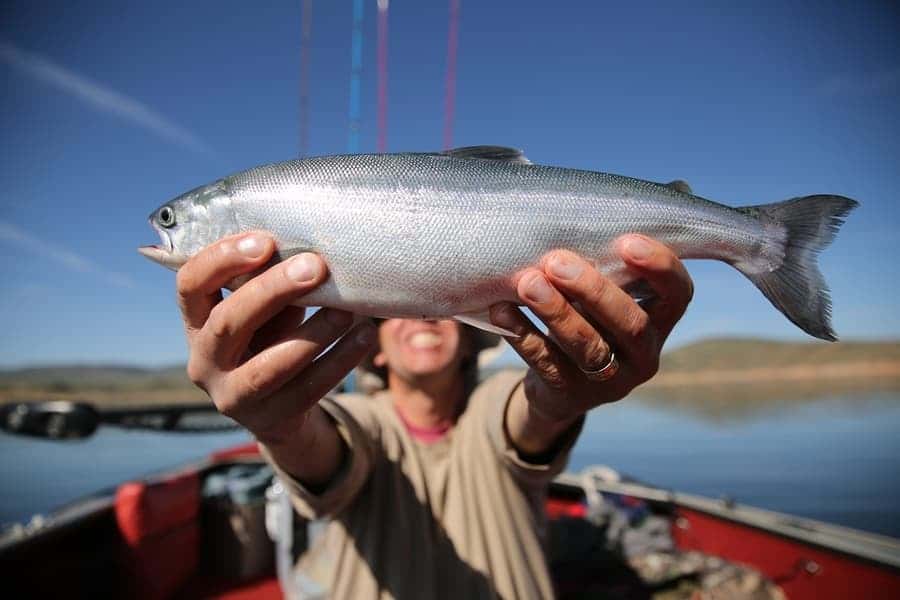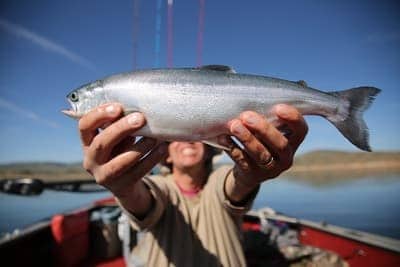
If you have a Jon Boat, there’s a near perfect chance that you’ll use it to fish at some point. That might be the entire reason that you bought it. No doubt, having a fish finder will give you eyes in the water and greatly help your chances of reeling in the big one. But what kind of fish finder is right for a Jon Boat?
First off, there isn’t really anything inherently different about a fish finder for a Jon Boat. Fish finders come in all shapes and sizes and so it can be a little overwhelming trying to decide on the right one. Jon Boats do have their own unique features that make selecting a fish finder vs. one for a bass or pontoon boat, and so I wanted to try to outline the main considerations below.
Main Difference in Fish Finders
Based on my research on and experience with a lot of different fish finders, it really seems that you can boil down your research and decision making criteria into four main buckets:
- Power source (internal or external)
- Transducer (permanent, portable, separately mounted like an arm, or none)
- Brand
- Overall features and cost
We’ll break down these four categories and offer some recommendations that fall into each category along the way. Remember that there isn’t a right or wrong decision when it comes to a fish finder, and there will be multiple decent options based on your criteria. Just use your best judgement and research and commit to one so that you can try it out and build your own reference points. This likely isn’t the last fish finder you’ll ever buy.
Consideration #1: Power
A big difference in fish finders you might consider will be their portability. In other words, are they designed to be permanently installed or portable from boat to boat? Generally speaking the more feature-rich fish finders will be built for permanent installation so and require a larger investment (but you get what you pay for).
Where this manifests itself is in the power source. Fish finders that are more portable and not permanently installed will generally have their own power source (i.e. battery operated). They will generally be less expensive and less feature-rich but that has its own set of advantages. Let’s walk through a few points on internally and externally powered fish finders.
Battery Operated Fish Finders
Portable power (battery powered) fish finders can be a great option for something like Jon Boats where the financial and logistical commitment can be smaller. A battery operated machine will be portable and require little to no installation on your boat. Plus not every Jon Boat will already have an external battery to use unless you perhaps have a trolling motor or other electric features.
Here a few popular and innovative fish finders that are battery operated and simple to use:
- Humminbird Helix 5 Sonar PT Fish Finder – This is an all-in-one kit that comes with a carrying case, suction cup transducer (we cover transducers more below), and already has built-in GPS. A little pricier than the next two options but you get the reliability and brand quality of Humminbird.
- Garmin Striker 4 – We love that this is packed with the power of Garmin GPS technology, is portable, and the transducer mounts quickly via suction cup (this has its downsides discussed below in the transducer section). It comes with a built-in rechargeable battery that based on my research appears to have a fairly decent lifespan.
- Humminbird Fishin’ Buddy – We love this if nothing else than for the portability and affordability. It’s very affordable and already comes with a mounting bracket so there is no installation really needed. Plus it’s battery powered by AA’s.
- Lowrance Fish Hunter Pro – If you want a different take on a fish finder set up, you could go with a completely separate unit that connects to your phone via wifi. This is a great versatile option that you can also use on a docks, kayaks, canoes, and so much more. Definitely worth considering.
Externally Powered Fish Finders
Most of the much nicer and permanently installed fish finders will need external power of some kind. In my opinion Jon Boats don’t necessarily need the large investment of a fully integrated electrical system to power a premium fish finder, but everyone is different.
When you are shopping for your fish finder be sure to understand its power source. If you are planning on using external power, make sure that you have enough power for everything you’ll need.
A Note on Batteries for Jon Boats
If you’re going to use an external battery to power things such as your fish finder, trolling motor, and more, make sure that you get a deep cycle marine battery and NOT a standard car battery. Deep cycle batteries are designed to be charged, run down, and charged again. Running them “dry” won’t hurt the battery and you’ll be able to charge them back up again. Have you ever completely used your car battery and you can’t even jump start it and have to replace it? A deep cycle battery won’t have that issue during its useful life which makes it suitable for boats, jet skis, RV’s, and more.
Can I Run a Fish Finder and a Trolling Motor on One Battery?
Generally speaking, yes. From a power perspective, 12 volts should be enough to run both of them but you’ll need to do some research on how to appropriately connect both devices to your battery and not get electric interference that can prevent one of them from working. We’ll put out more content on this topic in the future.
Consideration #2: Transducers
A big discussion point in the forums is around transducer application to Jon Boats. Where do I mount it, how do I mount it, etc? Let’s look at what a transducer is, what it does, and some options when it comes to mounting it to your Jon Boat.
What is a fish finder transducer? The transducer changes electricity into sound waves and sends those sound waves into the water and listens for echoes. Based on these echoes, the fish finder is able to map out out what it is seeing in the water. In essence, it’s the core technology of the fish finder.
Here’s a 39-second clip that visualizes how the transducer works:
How to Attach Fish Finder Transducer to a Jon Boat
This is where you need to make a fundamental decision about your fish finder that will in large part dictate what kind of fish finder you can get. The more sophisticated fish finders will generally need a permanently installed transducer attached to the hull (usually on the transom, i.e. the back of the boat) where there is a flat area that won’t be damaged by the trailer or contact with the ground.
Here are some options when it comes to the transducer. You’ll want to make sure to understand the various ways the transducer of your fish finder of choice can be installed and used. This is almost always covered in the product descriptions, or if you’re in person at your local boating shop, a service member will be able to explain it to you in more detail.
Permanently Installing Onto Transom
Because permanently installing a transducer to your aluminum boat can often mean puncturing and sealing the hull for installation, you’ll want to be very careful before you make any decisions.
In terms of placement of this transducer, generally you want to mount it on the transom of the boat (i.e. the very back where the hull is flat), and away from any place of contact your trailer might have with the boat.
If you frequently beach your boat you’ll want to take this into consideration in terms of both how and where you mount this transducer to prevent damage.
Attach to Trolling Motor
Some fish finder models will suggest that you attach the transducer to the trolling motor instead of the boat itself. There is plenty of YouTube content out there that is helpful in this area.
Attaching the transducer to the trolling motor can be a useful technique because often you will be fishing and operating the trolling motor at the same time, so having the transducer right beneath you will give you an accurate reading of the fish beneath you (versus the transducer 14 feet away on the other side of the boat).
Attach Via Suction Cup
Most entry level fish finder models will offer some version of a suction cup attachment that can be easily installed on-demand when you’re fishing. The obvious pro of this strategy is that it’s portable, easy to install, and doesn’t create any structural change or risk to your boat.
The downside is that if in shallow water it can become snagged and or detached on brush, weeds, etc. You’ll want to remove the transducer during cruise and then re-attach during fishing conditions. So, it leads to some manual labor each time you re-position the boat, but it’s certainly one of the quicker and more cost effective methods of deploying the transducer.
Attach Via an Arm
Rather than attaching the transducer to the boat or trolling motor itself, there are several options in deploying an arm that comes off the boat for the sole purpose of deploying the transducer. While this isn’t a good fit for bass or ski boats, it’s particularly useful for Jon Boats, kayaks, and canoes. Usually there is a clamp or clasp of some sort that will very easily secure to the side of the boat and you’re good to go. Here are a few models:
- Brocraft Universal Portable Transducer Bracket + Fishfinder Mount – This is extremely versatile and will prevent you from puncturing any holes in your boat to attach a transducer. Plus it can stay with you if you end up trading boats or going out with a friend on their boat. Plus it has a mount for the fish finder display as well.
- Brocraft Transducer Arm Mount – Same brand as above but you have to actually screw the mount into the side of the boat. If you’re wanting something a little more permanent but that doesn’t involve puncturing the hull of the boat, this can be a good option for you and at at the time of this writing it is a little cheaper than its removable counterpart in the previous link.
- Humminbird Fishin’ Buddy – This was mentioned up above but in case you missed it, this is an awesome entry level package that comes with the fish finder, transducer, and detachable arm mount all in one. Very approachable first purchase if you’re not looking for a hefty financial or logistical investment.
Don’t Mount It at All
Lastly, you could choose to not mount the transducer at all and go with one that is its own standalone unit. This can be a super flexible option if you want to also be able to use the fish finder you purchase for shore fishing, dock fishing, etc. Here are a few options:
- Lucky Fish Finder Wireless Portable Fishing Sonar – You won’t have the fancy permanent installation on the boat, but you’ll sure get a lot of versatility out of this model. You can even use it for pond fishing, ice fishing, and more.
- ActionEliters Fish Finder with Wireless Sonar Sensor – The reason we like this model is that the display actually comes with a wrist strap. This is great for Jon Boats as there isn’t always a great place to install the actual fish finder screen. This makes a great gift as well since it’s so versatile and compact.
Consideration #3: Brand
While there’s something to be said for getting good brands, the rise of crowdsourcing and public reviews on websites has really started to even the playing field for newer brands to come in and be reputable early on. Be sure to check Amazon reviews and feedback to get a good idea of some of the frequently asked questions and troubleshooting comments customers have made about the product. My recommendations are based on my own experience and also hours and hours of research when writing these articles and more.
Humminbird is my fish finder of choice based on my own personal experience and that of my friends. It’s a tried and true brand that is known for simply doing its job. It’s not as customizable as some of the other brands like Lowrance but is certainly a safe investment and will perform as advertised.
Lowrance similarly is a big brand in the industry, however I do hear more articles, reviews, and stories about issues and troubleshooting the device. They are well known for networking between their products, so if you plan to have more than one fish finding screen on your boat, Lowrance products are great for this. That might be a little more applicable for larger boats than Jon Boats, but I still wanted to mention it. If it’s between these two brands I would personally suggest Humminbird (which is annoying to type because every word processor underlines it red for assuming it’s a misspelling of “Hummingbird”).
Garmin is a personal favorite of mine because I am also a pilot. Garmin is the Mercedes Benz of avionics in my opinion and they do equally well in just about any other GPS technology you can mention (exercise watches, personal GPS units for cars, etc.). While they aren’t as longstanding in the fishing arena they do have the infrastructure and technology to put out some really high quality products. I would not be afraid to purchase Garmin technology for my boat.
Integrate Your Devices the Best You Can
One final word on brands is that it’s probably a good idea to try and plan ahead as to the other devices you might get on your boat and make sure that they can integrate. For example, certain GPS fish finders will integrate with your trolling motor for wireless trolling. Be sure to research some of the compatibilities of the brands you are considering as it might make you happier in the future that you planned ahead.
Consideration #4: Cost
I recognize that I put cost as the last consideration, however I understand that will likely be the #1 or #2 consideration for most people when it comes to purchasing new equipment for your boat. The reason I put it last is that it shouldn’t be the only thing that is driving your decision between fish finders. As you can tell, it isn’t as simple as just selecting which model you like best, and there are many other considerations for how you will both install and use the fish finder over time that will start to inform your purchasing decision.
Generally speaking, features will drive cost the most on fish finders. Adding GPS technology will significantly up the price, however there are some affordable options mentioned above that come with GPS already installed.
If you’re just getting into fishing and want an entry level choice, I recommend starting small and not making too many (if any) structural changes to your boat. Start with a versatile and easy to use fish finder and work your way up once you understand your needs and preferences even more. Knowing where the fish are doesn’t have to break the bank on day one.
However much you do end up spending though, just remember that a bad day of fishing is still better than a good day of work!

